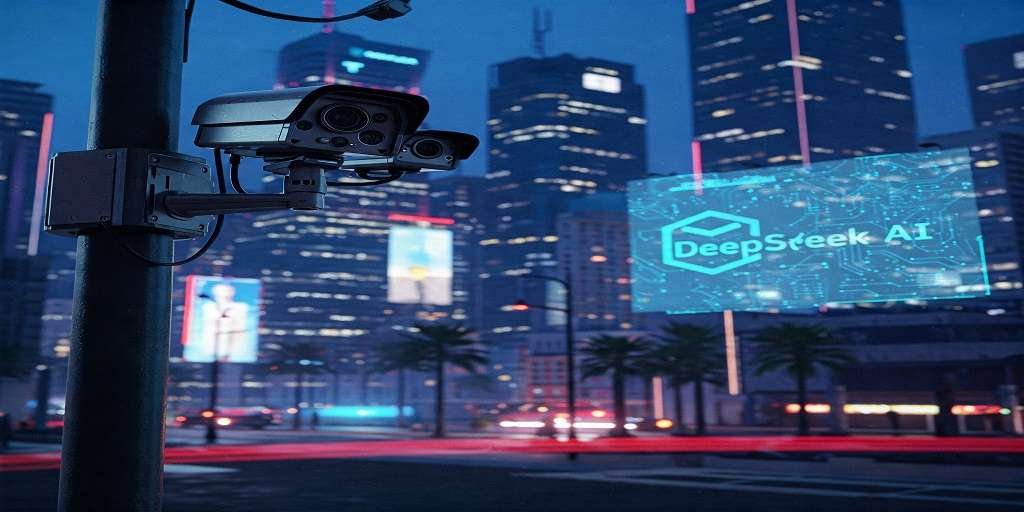The Future of Surveillance:
Integrating Cutting-Edge Security Cameras with DeepSeek’s AI for Smarter, Safer Communities
Introduction
The rapid evolution of artificial intelligence (AI) and computer vision has transformed the landscape of security and surveillance. In the European Union, where privacy regulations like GDPR coexist with the demand for public safety, the integration of advanced security cameras with large language models (LLMs) like DeepSeek presents unprecedented opportunities. This fusion promises not only enhanced threat detection but also ethical, efficient, and intelligent systems that align with Europe’s values of transparency and human-centric innovation.
In this blog, we explore how combining next-generation security camera technologies with DeepSeek’s multimodal capabilities could redefine urban safety, industrial operations, and private-sector security—while addressing the EU’s unique regulatory and ethical challenges.

1. The Evolution of Security Cameras: From Passive Recording to Active Intelligence
Modern security cameras are no longer mere recording devices. Equipped with 4K/8K resolution, thermal imaging, LiDAR, and edge computing, they now generate vast amounts of multimodal data—video, audio, temperature, and spatial information. However, the true potential of these systems remains untapped without AI that can interpret context, predict risks, and respond dynamically.
Key Innovations in Security Cameras:
- Edge AI Processors: On-device processing reduces latency and ensures GDPR-compliant data handling.
- Multispectral Imaging: Combines visible light, infrared, and ultraviolet data for all-weather monitoring.
- 3D Spatial Mapping: LiDAR-enabled cameras create real-time 3D models of environments, critical for crowd management or accident reconstruction.
- Behavioral Analytics: Algorithms detect anomalies like loitering, falls, or unattended objects.
Yet, these systems often operate in silos, lacking the contextual awareness to distinguish between a harmless stray animal and a genuine security threat. This is where DeepSeek’s multimodal LLM steps in.
2. DeepSeek’s Role: Bridging Perception and Cognition
DeepSeek, a state-of-the-art LLM, excels in processing and correlating diverse data types—text, images, audio, and sensor inputs. When integrated with security systems, it acts as a “cognitive layer,” transforming raw data into actionable insights.
How It Works:
- Real-Time Multimodal Analysis:
- Cameras feed video streams, audio snippets, and metadata to DeepSeek.
- The model cross-references this data with historical patterns, weather reports, and even social media trends (e.g., detecting protests or emergencies).
- Example: A camera in a Brussels metro station detects an unattended bag. DeepSeek checks recent announcements for lost items and analyzes passenger behavior to assess threat levels.
- Natural Language Interaction:
- Security personnel query the system using conversational language: “Show all vehicles near the warehouse after 10 PM.”
- DeepSeek generates summaries, highlights anomalies, and even suggests responses.
- Predictive Maintenance:
- By analyzing camera health data, DeepSeek predicts hardware failures or tampering, reducing downtime.
3. Use Cases Aligned with EU Priorities
A. Smart Cities & Public Safety
The EU’s “Safe Cities Initiative” aims to reduce urban crime by 30% by 2030. Integrated systems could:
- Prevent Terrorist Threats: DeepSeek correlates camera data with police databases to flag suspicious individuals while avoiding racial profiling.
- Traffic Management: Cameras monitor congestion, while DeepSeek optimizes traffic light patterns and reroutes emergency vehicles.
- Disaster Response: During floods or fires, thermal cameras identify trapped individuals, and DeepSeek guides rescue teams via augmented reality (AR) interfaces.
B. Retail & GDPR-Compliant Analytics
EU retailers face strict limits on biometric data. A hybrid approach ensures compliance:
- Anonymous Crowd Analytics: Cameras count shoppers, while DeepSeek analyzes foot traffic to optimize store layouts—without facial recognition.
- Fraud Detection: Suspicious behaviors (e.g., repeated shelf scanning) trigger alerts, with human reviewers validating incidents.
C. Industrial Safety
In Germany’s Industry 4.0 factories:
- Hazard Detection: Cameras spot PPE violations or machinery leaks. DeepSeek translates alerts into multilingual instructions for workers.
- Supply Chain Transparency: Combined with blockchain, cameras and DeepSeek verify ethical sourcing by monitoring warehouse conditions.
4. Navigating EU Regulations: Privacy by Design
The EU’s AI Act and GDPR mandate transparency, minimal data collection, and human oversight. Integration with DeepSeek must adhere to:
- Federated Learning: Train AI models on decentralized camera data to avoid centralized storage.
- Explainable AI (XAI): DeepSeek provides audit trails for decisions (e.g., “Alert triggered due to 80% match with known shoplifting patterns”).
- Dynamic Blurring: Cameras automatically blur faces/license plates, with DeepSeek ensuring only authorized users access raw data.
5. Challenges and Solutions
A. Energy Efficiency:
- Problem: High-resolution cameras and LLMs consume significant power.
- Solution: Use neuromorphic chips and spiking neural networks for energy-efficient processing.
B. Bias Mitigation:
- Problem: Training data may reflect historical biases.
- Solution: Curate diverse datasets and implement the EU’s Ethics Guidelines for Trustworthy AI.
C. Cyber Threats:
- Problem: Hackers targeting AI models.
- Solution: Deploy homomorphic encryption and regular audits by ENISA (EU Cybersecurity Agency).
6. The Road Ahead: A Collaborative Ecosystem
For the EU to lead in ethical AI-powered surveillance, collaboration is key:
- Public-Private Partnerships: Pilot projects funded by Horizon Europe.
- Standardization: CEN-CENELEC creating interoperability frameworks.
- Citizen Engagement: Transparent AI dashboards where residents query how data is used.
Conclusion
The marriage of advanced security cameras and DeepSeek’s AI isn’t just about sharper images or faster alerts—it’s about building systems that respect privacy, empower humans, and anticipate risks before they escalate. For the EU, this represents a chance to pioneer a global standard: surveillance that safeguards both security and civil liberties.
As cameras grow smarter and AI more intuitive, the question isn’t just what these technologies can do, but how Europe will shape their evolution. The answer lies in innovation rooted in ethics, collaboration, and an unwavering commitment to human dignity.




